North America Industrial Air Quality Control Systems Market Size
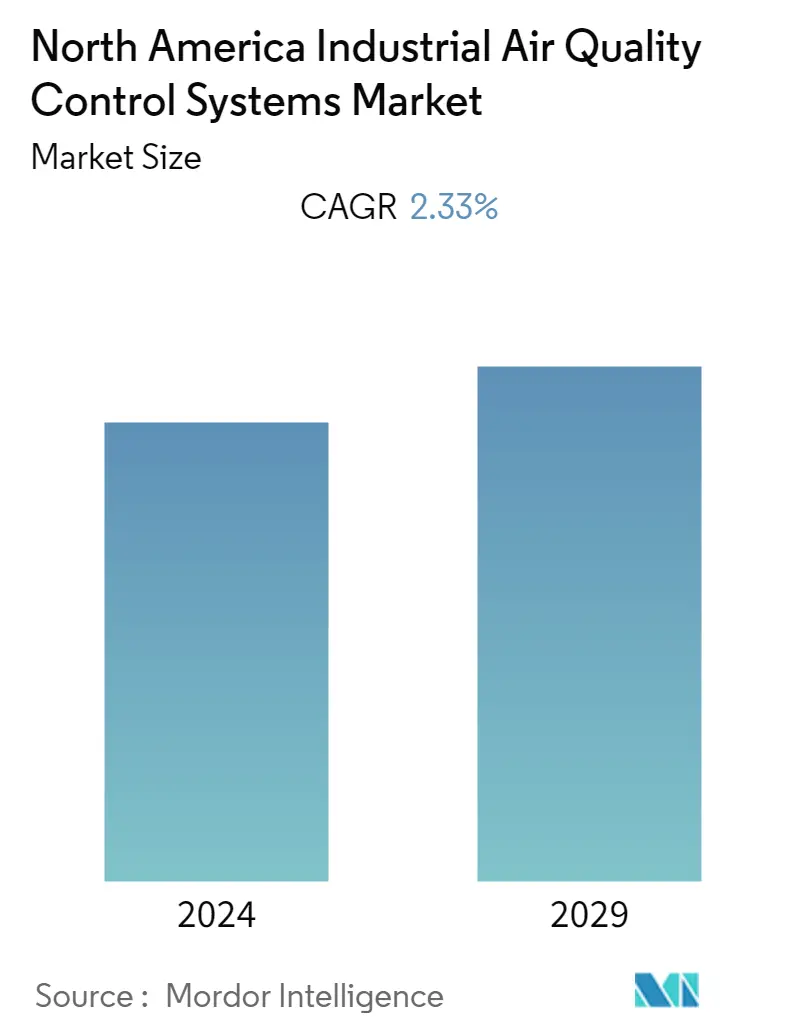
| Study Period | 2020 - 2029 |
| Base Year For Estimation | 2023 |
| Forecast Data Period | 2024 - 2029 |
| Historical Data Period | 2020 - 2022 |
| CAGR | 2.33 % |
| Market Concentration | Medium |
Major Players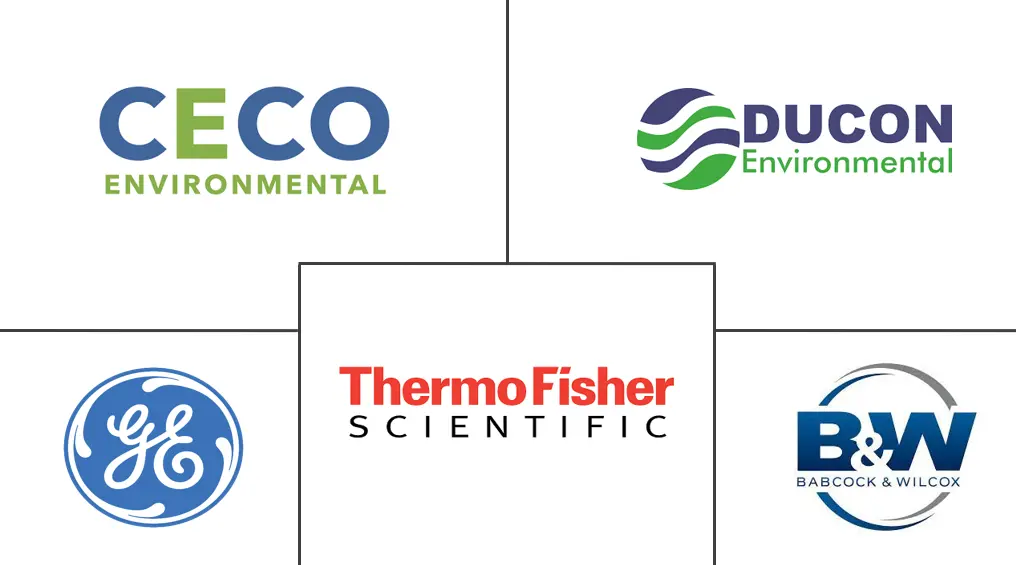
*Disclaimer: Major Players sorted in no particular order |
North America Industrial Air Quality Control Systems Market Analysis
The North America Industrial Air Quality Control Systems Market size is estimated at USD 4.37 billion in 2023, and is expected to reach USD 4.90 billion by 2028, growing at a CAGR of 2.33% during the forecast period (2023-2028).
- Over the medium term, the market is expected to be driven by strict government regulations to control air pollution.
- On the other note, increasing adoption of renewable energy is expected to hinder market growth during the forecast period.
- Nevertheless, significant opportunities in the cement and steel industry. This, in turn, is expected to create a significant opportunity for industrial air quality control system providers to tap into this market.
- United Staes is expected to dominate the market, with most of the demand coming from numorous end-use indutries.
North America Industrial Air Quality Control Systems Market Trends
Power Generation Industry Segment to Witness Significant Growth
- Power generation through fossil fuels is one of the significant causes of air pollution and a leading cause of global warming emissions worldwide. Power plant emissions have extensive effects and can cause long-lasting impacts like air pollution.
- Fossil fuel-based energy is released from thermal power plants that burn fossil fuels, such as natural gas or coal, to produce electricity. The burning of fossil fuels at power plants produces emissions, including nitrogen oxide (NOX), sulfur dioxide (SO2), particulate matter (PM), carbon dioxide (CO2), mercury (Hg), and other pollutants.
- In 2021, according to the United States Energy Information Administration (EIA), the power sector in the United States produced 11,539 million metric tons (MMmt) of carbon dioxide emissions. This had been the most significant annual increase in emissions since 2010. In 2022, emissions in the United States rebounded rapidly as the country looked to recover from the COVID-19 pandemic. Despite the increase in 2022, power sector emissions in the United States were still the second lowest for more than two decades and 36% lower than in 2007, when they peaked at 2.4 GtCO2.
- Coal power plants in the United States emitted 847 million metric tons of carbon dioxide (MtCO2) in 2022. Despite the increase, coal continues to be the primary source of electricity-related emissions in the United States. Coal power plant emissions declined to an all-time low of 787 MtCO2 in 2020. The decline in emissions was due to the phasing out of coal as a source of electricity generation and shifting toward natural gas electric power in the United States. The electric power industry emissions in the United States are highest in Texas for coal and natural gas.
- In 2021, Canada's power sector's carbon dioxide emissions amounted to 78.8 million metric tons (MtCO). This was increased by approximately 4.09 % compared to the previous year. Power sector emissions in Canada declined from 135.5 MtCO in 2000 to 78.8 MtCO in 2022. Since then, emissions have plunged significantly between 2000 and 2022.
- In July 2022, Canada announced the Emissions Reduction Plan 2030, an ambitious and feasible roadmap for Canada's subsequent steps for clean air and a strong economy. The plan summarizes a sector-by-sector approach for Canada to achieve its emissions reduction target of 40% by 2030 and net-zero emissions by 2050.
- Therefore, the set emission targets sector-by-sector is expected to witness significant demand for air quality control systems in the power generation industry during the forecast period.
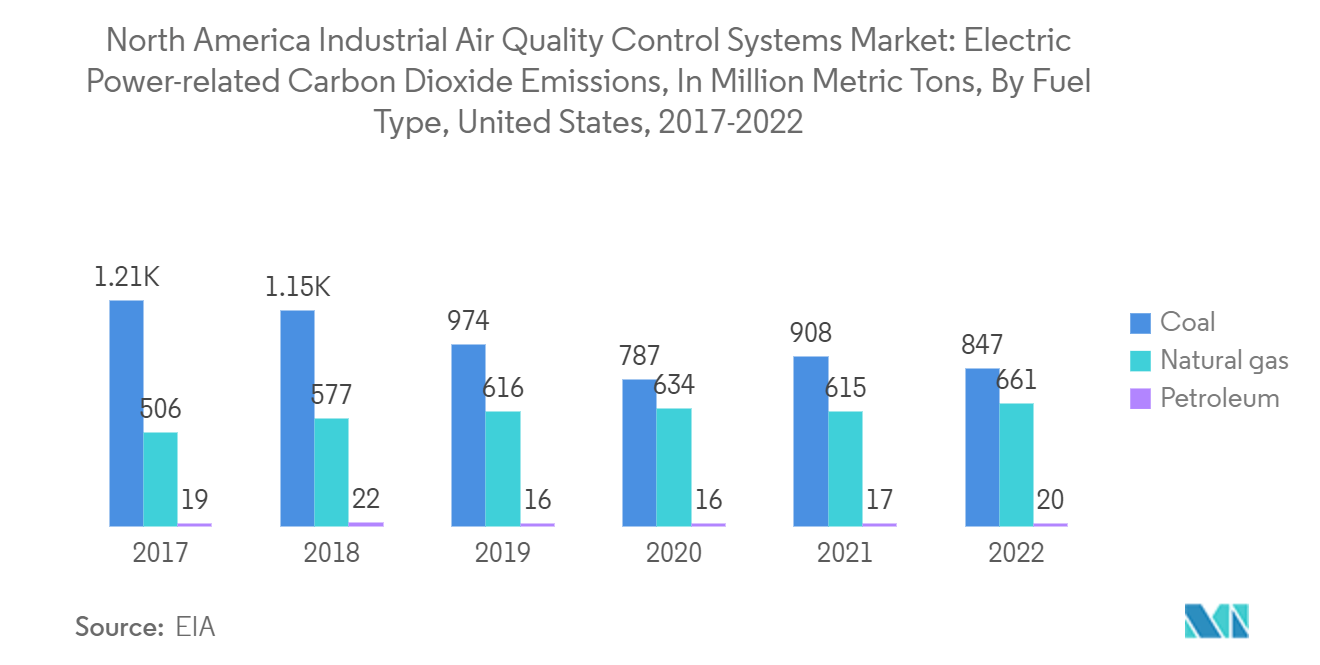
United States to Dominate the Market
- The United States is expected to be one of the largest markets for industrial air quality control systems in North America owing to the significant greenhouse gas emissions contributions from the power generation, Industrial, and automobile sectors.
- According to the US Energy Information Administration (EIA), CO2 emissions from the energy consumption in the United States, contributed about 4,970 million metric ton of CO2 in 2022. Though there was a slight rise in CO2 emissions in 202w, the emissions have fallen significantly in recent decades as the country shifts toward cleaner energy sources and phases out coal.
- However, in 2021, more than 90% of the cities in the United States could not get below the WHO annual 5 μg/m³ guideline for PM2.5 levels, with those cities accounting for more than 98% of the region's population. The primary sources of pollution were gas and diesel-powered transportation, coal-based energy generation industrial emissions, and wildfires.
- In addition to power generation, the adoption of industrial air quality control systems is expected to come from the rapid growth in the automobile, oil and gas, steel, cement manufacturing, and chemical sector during the forecast period.
- The United States is witnessing the strongest developments in the automobile industry in recent years. The country has one of the largest automotive markets in the world. According to the US Bureau of Economic Analysis, the total vehicle sales in the United States in November 2022 was more than 14.6 million units, recording about an 8% rise from the same month of 2021. Overall, the United States is the world's second-largest vehicle sales and production market after China. Further, the country is likely to witness massive investments in the automotive sector, which will likely increase the growth of the industrial air quality control systems market in the future.
- Therefore, with increasing investments across the industries in the United States is expected to dominate the industrial air quality control systems market during the forecast period.
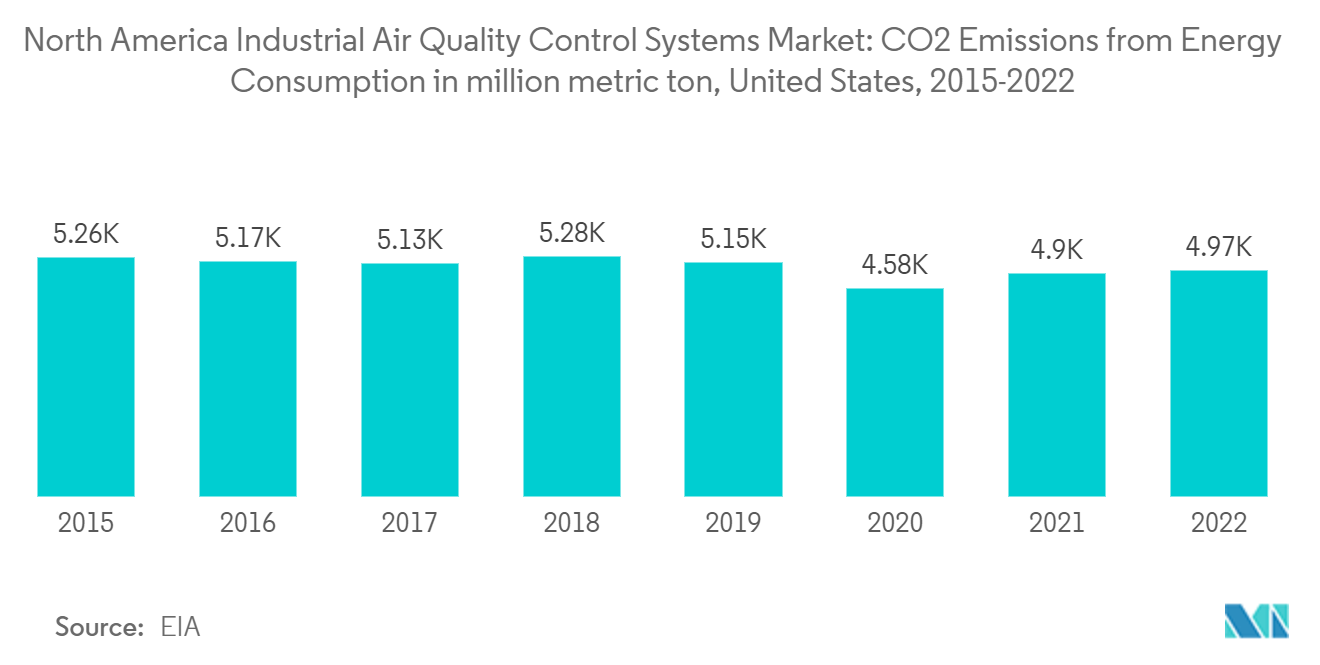
North America Industrial Air Quality Control Systems Industry Overview
The North America industrial air quality control systems market is moderately fragmented in nature. Some of the major players in the market (in no particular order) include Babcock & Wilcox Enterprises Ltd, Ducon Technologies Inc, General Electric Company, CECO Environmental Corporation, and Thermo Fisher Scientific Inc., among others.
North America Industrial Air Quality Control Systems Market Leaders
-
General Electric Company
-
Babcock & Wilcox Enterprises Ltd
-
Thermo Fisher Scientific Inc.
-
Ducon Technologies Inc
-
CECO Environmental Corporation
*Disclaimer: Major Players sorted in no particular order
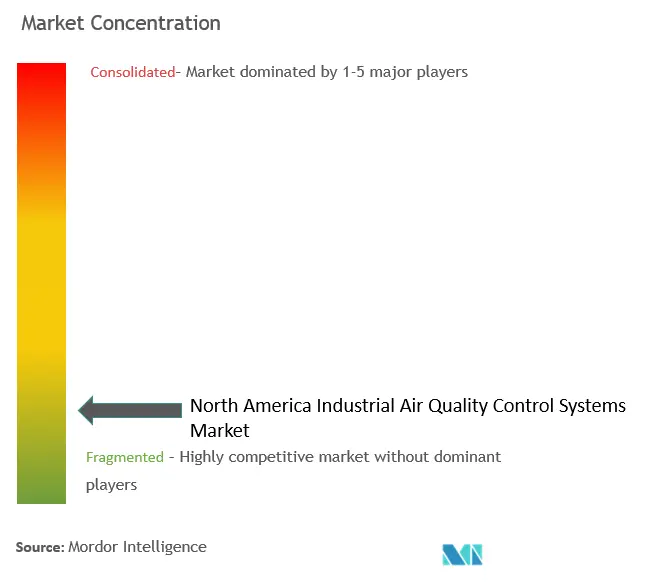
North America Industrial Air Quality Control Systems Market News
- In December 2022, General Electric Company announced a technical solution to reduce carbon emissions. The solution includes engineering studies for integrating and installing a Selective Catalytic Reduction (SCR) technology system. The solution reduced nitrogen oxide (NOx) and carbon monoxide (CO) emissions by over 90%, surpassing World Bank Emissions Standards.
- In December 2022, ProcessBarron, an air and gas handling products manufacturer in the United States, announced the establishment of its wholly-owned subsidiary in Toronto, Canada. The new subsidiary is likely to provide electrostatic precipitator and air pollution control services through its Southern Field-Environmental Elements division.
North America Industrial Air Quality Control Systems Market Report - Table of Contents
1. INTRODUCTION
1.1 Scope of the Study
1.2 Market Definition
1.3 Study Assumptions
2. EXECUTIVE SUMMARY
3. RESEARCH METHODOLOGY
4. MARKET OVERVIEW
4.1 Introduction
4.2 Market Size and Demand Forecast in USD, till 2028
4.3 Recent Trends and Developments
4.4 Government Policies and Regulations
4.5 Market Dynamics
4.5.1 Drivers
4.5.1.1 Presence of Strict Government Regulations to Control Air Pollution
4.5.2 Restraints
4.5.2.1 Increasing Adoption of Renewable Energy
4.6 Supply Chain Analysis
4.7 Porter's Five Forces Analysis
4.7.1 Bargaining Power of Suppliers
4.7.2 Bargaining Power of Consumers
4.7.3 Threat of New Entrants
4.7.4 Threat of Substitute Products and Services
4.7.5 Intensity of Competitive Rivalry
5. MARKET SEGMENTATION
5.1 Type
5.1.1 Electrostatic Precipitators (ESP)
5.1.2 Flue Gas Desulfurization (FGD) and Scrubbers
5.1.3 Selective Catalytic Reduction (SCR)
5.1.4 Fabric Filters
5.1.5 Others
5.2 Application
5.2.1 Power Generation Industry
5.2.2 Cement Industry
5.2.3 Chemicals and Fertilizers
5.2.4 Iron and Steel Industry
5.2.5 Automotive Industry
5.2.6 Oil & Gas Industry
5.2.7 Other Applications
5.3 Emissions (Qualitative Analysis only)
5.3.1 Nitrogen Oxides (NOx)
5.3.2 Sulphur Oxides (SO2)
5.3.3 Particulate Matter (PM)
5.4 Geography
5.4.1 United States
5.4.2 Canada
5.4.3 Mexico
6. COMPETITIVE LANDSCAPE
6.1 Mergers and Acquisitions, Joint Ventures, Collaborations, and Agreements
6.2 Strategies Adopted by Leading Players
6.3 Company Profiles
6.3.1 Babcock & Wilcox Enterprises Ltd
6.3.2 Ducon Technologies Inc
6.3.3 General Electric Company
6.3.4 Pollution Systems
6.3.5 LDX Solutions
6.3.6 CECO Environmental Corporation
6.3.7 FuelTech Inc
6.3.8 Thermo Fisher Scientific Inc.
6.3.9 Tri-Mer Corporation
6.3.10 Sly Inc
- *List Not Exhaustive
7. MARKET OPPORTUNITIES AND FUTURE TRENDS
7.1 Significant Opportunities in the Cement and Steel Industry
North America Industrial Air Quality Control Systems Industry Segmentation
Air Quality Control Systems (AQCS) include control systems that reduce the proportion of pollutants from flue gases emitted from exhausts of power plants and other industries majorly fuelled by fossil fuels.
The North America industrial air quality control systems market is segmented by type, application, emissions (Qualitative Analysis only), and geography. By type, the market is segmented into Electrostatic Precipitators (ESP), Flue Gas Desulfurization (FGD) and Scrubbers, Selective Catalytic Reduction (SCR), Fabric Filters, Others. By application, the market is segmented into Power Generation Industry, Cement Industry, Chemicals and Fertilizers, Iron and Steel Industry, Automotive Industry, Oil & Gas Industry, and Other Applications. By emissions (Qualitative Analysis only), the market is segmented into Nitrogen Oxides (NOx), Sulphur Oxides (SO2), Particulate Matter (PM). The report also covers the market size and forecasts for North America industrial air quality control systems market across major countries. For each segment, the market sizing and forecasts have been done based on revenue (value in USD).
| Type | |
| Electrostatic Precipitators (ESP) | |
| Flue Gas Desulfurization (FGD) and Scrubbers | |
| Selective Catalytic Reduction (SCR) | |
| Fabric Filters | |
| Others |
| Application | |
| Power Generation Industry | |
| Cement Industry | |
| Chemicals and Fertilizers | |
| Iron and Steel Industry | |
| Automotive Industry | |
| Oil & Gas Industry | |
| Other Applications |
| Emissions (Qualitative Analysis only) | |
| Nitrogen Oxides (NOx) | |
| Sulphur Oxides (SO2) | |
| Particulate Matter (PM) |
| Geography | |
| United States | |
| Canada | |
| Mexico |
North America Industrial Air Quality Control Systems Market Research FAQs
What is the current North America Industrial Air Quality Control Systems Market size?
The North America Industrial Air Quality Control Systems Market is projected to register a CAGR of 2.33% during the forecast period (2024-2029)
Who are the key players in North America Industrial Air Quality Control Systems Market?
General Electric Company, Babcock & Wilcox Enterprises Ltd, Thermo Fisher Scientific Inc., Ducon Technologies Inc and CECO Environmental Corporation are the major companies operating in the North America Industrial Air Quality Control Systems Market.
What years does this North America Industrial Air Quality Control Systems Market cover?
The report covers the North America Industrial Air Quality Control Systems Market historical market size for years: 2020, 2021, 2022 and 2023. The report also forecasts the North America Industrial Air Quality Control Systems Market size for years: 2024, 2025, 2026, 2027, 2028 and 2029.
North America Industrial Air Quality Control Systems Industry Report
Statistics for the 2024 North America Industrial Air Quality Control Systems market share, size and revenue growth rate, created by Mordor Intelligence™ Industry Reports. North America Industrial Air Quality Control Systems analysis includes a market forecast outlook to 2029 and historical overview. Get a sample of this industry analysis as a free report PDF download.



